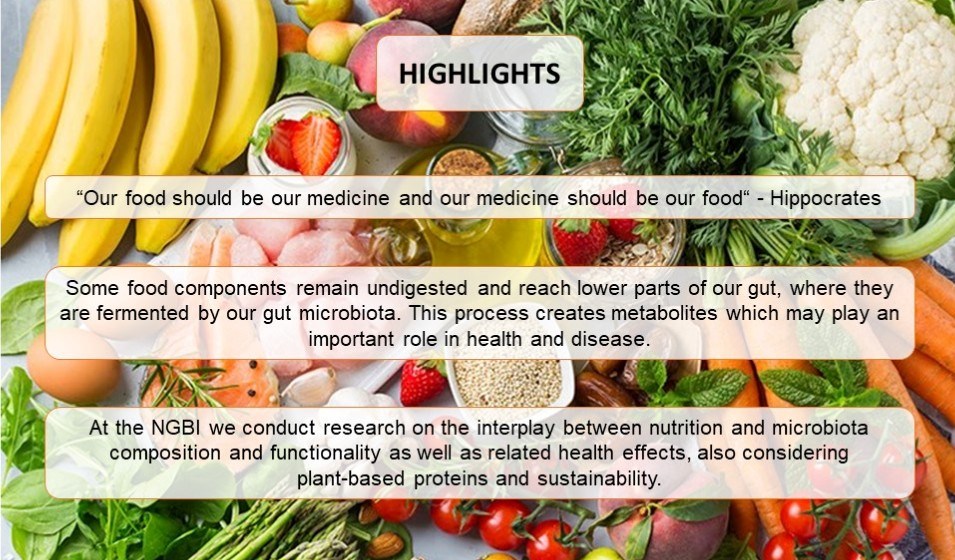Nutrition
Already very early in history people realised that diet has a substantial impact on our health and wellbeing, as stated for instance by the Greek physician Hippocrates: “Our food should be our medicine and our medicine should be our food“.
Indeed, the sufficient uptake of nutrients is crucial for various aspects of the functioning of our body. Carbohydrates, fats, and proteins are called macronutrients and the main provider of energy, but also the building blocks within our body.

Micronutrients on the other hand comprise vitamins and minerals which play a key role in biochemical processes, gene transcription and are important for tissue function (1). Therefore, a well-balanced diet that provides a variety of essential nutrients promotes our health and wellbeing and could help in decreasing the risk of developing diseases such as obesity, diabetes mellitus, cardiovascular disease, or some types of cancer (2).
However, some food components escape digestion and absorption since we do not produce all enzymes needed to break down every food compound (e.g., dietary fibre). The undigested food particles reach the lower parts of the gut which is inhabited by a vast number of different microorganisms, collectively called microbiota. These microorganisms are able to produce the enzymes we are lacking to degrade e.g. dietary fibres – this process is called fermentation. Subsequently, fermentation products are released and can either be utilised by the gut cells, reach our bloodstream by passing through the gut wall, or simply be excreted in the faeces. These metabolites have different functions, and their identification and health- and disease-related effects remain to be well studied.
At the NGBI research centre we cover research on the interplay between nutrition and microbiota composition and functionality as well as related health effects, especially by conducting a variety of different dietary intervention studies in different populations (e.g., elderly, healthy and diseased).
We have previously demonstrated that dietary fibres can protect against stress-induced gut hyperpermeability in both patients with Crohn’s disease and elderly but not against drug-induced hyperpermeability. We have also demonstrated that elderly consume much less fibre than recommended (3,4,5). Currently, we are investigating the effect of dietary fibre in patients with microscopic colitis (6) and in patients with pre-diabetes (7,8).
In our research, we also address the need of sustainably produced food with health benefits, also considering tailored nutrition. We are a part of the Sweden-wide, inter-disciplinary and inter-sectoral Plant-based Proteins for Health and Wellbeing - PAN Sweden Research Centre (9) which embeds the Precision Nutrition Innovation Arena (PNI) (10) coordinated by Örebro University. It has recently been established with the aim to pursue the vision that consumers can choose the healthiest food based on the optimal match with their individual needs. Within the scope of PAN Sweden, we conduct dietary intervention studies on the effect of plant-based proteins on gut, metabolic and mental health (11).
- Shenkin A. (2006). The key role of micronutrients. Clinical nutrition (Edinburgh, Scotland), 25(1), 1–13. https://doi.org/10.1016/j.clnu.2005.11.006
- Diet, nutrition and the prevention of chronic diseases. (2003). World Health Organization technical report series, 916
- Ganda Mall, J. P., Casado-Bedmar, M., Winberg, M. E., Brummer, R. J., Schoultz, I., & Keita, Å. V. (2017). A β-Glucan-Based Dietary Fiber Reduces Mast Cell-Induced Hyperpermeability in Ileum From Patients With Crohn's Disease and Control Subjects. Inflammatory bowel diseases, 24(1), 166–178. https://doi.org/10.1093/ibd/izx002
- Ganda Mall, J. P., Löfvendahl, L., Lindqvist, C. M., Brummer, R. J., Keita, Å. V., & Schoultz, I. (2018). Differential effects of dietary fibres on colonic barrier function in elderly individuals with gastrointestinal symptoms. Scientific reports, 8(1), 13404. https://doi.org/10.1038/s41598-018-31492-5
- Ganda Mall, J. P., Östlund-Lagerström, L., Lindqvist, C. M., Algilani, S., Rasoal, D., Repsilber, D., Brummer, R. J., Keita, Å. V., & Schoultz, I. (2018). Are self-reported gastrointestinal symptoms among older adults associated with increased intestinal permeability and psychological distress?. BMC geriatrics, 18(1), 75. https://doi.org/10.1186/s12877-018-0767-6
- https://www.oru.se/nyheter/nyhetsarkiv/nyhetsarkiv-2021/testar-fiber-som-skonsam-medicin-mot-magproblem/
- https://www.oru.se/forskning/forskningsmiljoer/mh/nutrition-gut-brain-interactions-research-centre-ngbi/nyheter/forskar-om-smorsyra-och-typ-2-diabetes--rebecca-wall-far-tva-miljoner-fran-formas/
- https://www.oru.se/nyheter/nyhetsarkiv/nyhetsarkiv-2019/ny-studie--forskarna-vill-forhindra-utvecklingen-av-typ-2-diabetes-med-fibrer/
- https://www.oru.se/english/strategic-initiatives/food-and-health/pan-sweden/
- https://www.oru.se/english/strategic-initiatives/food-and-health/pan-sweden/PNI/
- https://www.oru.se/nyheter/nyhetsarkiv/nyhetsarkiv-2021/samira-prado-far-21-miljoner-for-att-studera-vaxtproteinernas-effekter-pa-halsan/
